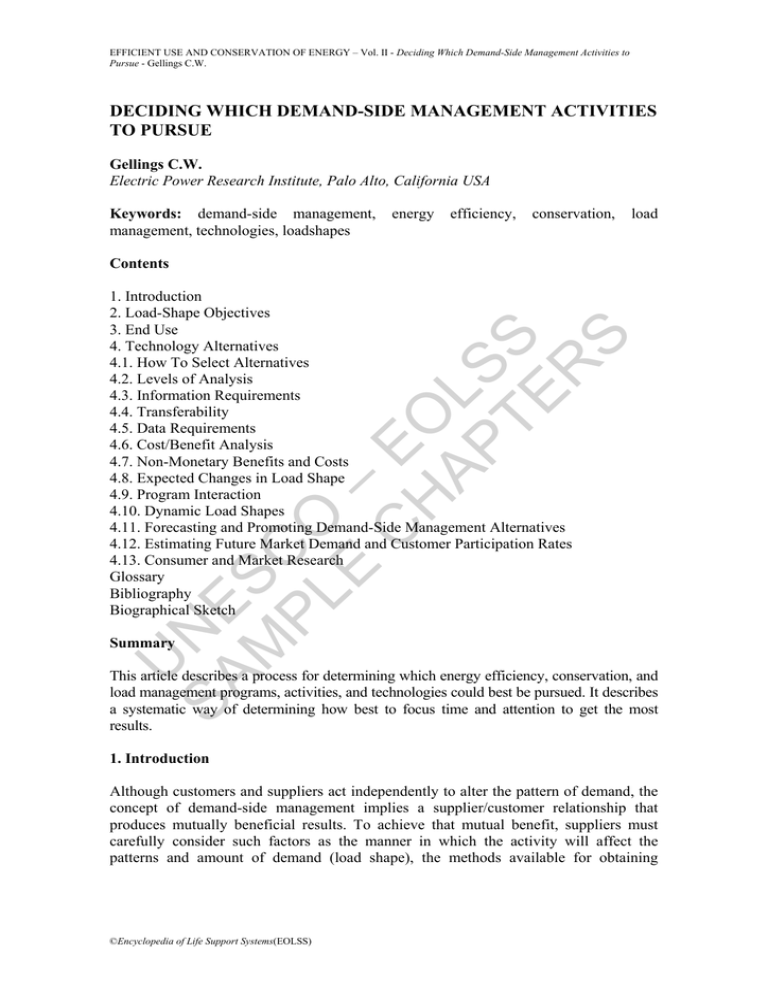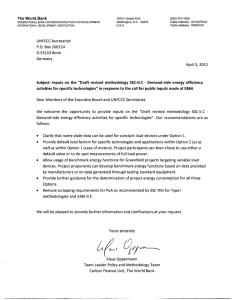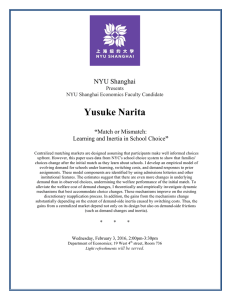Deciding Which Demand-Side Management Activities to
advertisement

EFFICIENT USE AND CONSERVATION OF ENERGY – Vol. II - Deciding Which Demand-Side Management Activities to Pursue - Gellings C.W. DECIDING WHICH DEMAND-SIDE MANAGEMENT ACTIVITIES TO PURSUE Gellings C.W. Electric Power Research Institute, Palo Alto, California USA Keywords: demand-side management, management, technologies, loadshapes energy efficiency, conservation, load Contents U SA NE M SC PL O E – C EO H AP LS TE S R S 1. Introduction 2. Load-Shape Objectives 3. End Use 4. Technology Alternatives 4.1. How To Select Alternatives 4.2. Levels of Analysis 4.3. Information Requirements 4.4. Transferability 4.5. Data Requirements 4.6. Cost/Benefit Analysis 4.7. Non-Monetary Benefits and Costs 4.8. Expected Changes in Load Shape 4.9. Program Interaction 4.10. Dynamic Load Shapes 4.11. Forecasting and Promoting Demand-Side Management Alternatives 4.12. Estimating Future Market Demand and Customer Participation Rates 4.13. Consumer and Market Research Glossary Bibliography Biographical Sketch Summary This article describes a process for determining which energy efficiency, conservation, and load management programs, activities, and technologies could best be pursued. It describes a systematic way of determining how best to focus time and attention to get the most results. 1. Introduction Although customers and suppliers act independently to alter the pattern of demand, the concept of demand-side management implies a supplier/customer relationship that produces mutually beneficial results. To achieve that mutual benefit, suppliers must carefully consider such factors as the manner in which the activity will affect the patterns and amount of demand (load shape), the methods available for obtaining ©Encyclopedia of Life Support Systems(EOLSS) EFFICIENT USE AND CONSERVATION OF ENERGY – Vol. II - Deciding Which Demand-Side Management Activities to Pursue - Gellings C.W. customer participation, and the likely magnitudes of costs and benefits to both supplier and customer prior to attempting implementation. Because there are so many demand-side alternatives in energy utilization, the process of identifying potential candidates can be carried out more effectively by considering several aspects of the alternatives in an orderly fashion. Demand-side activities can be categorized in a two-level process in which the second level has three steps: level I (load-shape objectives) and level II (end use, technology alternatives, and market implementation methods). U SA NE M SC PL O E – C EO H AP LS TE S R S Load-shape objectives, end uses, and technology alternatives are presented in this article. Market implementation methods are described separately in Market Implementation Methods. 2. Load-Shape Objectives Figure 1. Characterization of demand-side management alternatives The first step in identifying demand-side alternatives is typically the selection of an appropriate load-shape objective to ensure that the desired result is consistent with goals and constraints.Figure 1 refers to the change of load-shape objectives available. For ©Encyclopedia of Life Support Systems(EOLSS) EFFICIENT USE AND CONSERVATION OF ENERGY – Vol. II - Deciding Which Demand-Side Management Activities to Pursue - Gellings C.W. example: electric load forecasts for an area, country, or market may indicate that existing and planned generating capacity will fall short of projected demand plus targeted reserve margins by 100 megawatts within 7 to 10 years. Several supply-side alternatives may be available to meet this capacity shortfall: additional peaking capacity can be built, extra power can be purchased as needed from other generating utilities, or perhaps a reduction in reserve margin can be tolerated.There are also a number of demand-side alternatives, including direct load control, interruptible rates, and residential thermal storage, that can augment the number of planning alternatives available.Choosing between meeting the 100-MW peak unit versus reducing the peak becomes a balance between the costs and benefits associated with the range of available supply-side and demand-side alternatives. 3. End Use U SA NE M SC PL O E – C EO H AP LS TE S R S Once the load-shape objective has been established, it is necessary to find ways to achieve it. This is the second level in the identification process, which involves three steps or dimensions. The first dimension involves identifying the appropriate end uses whose peak load and energy consumption characteristics generally match the requirements of the load-shape objectives. In general, each end use (e.g., residential space heating, commercial lighting) exhibits typical and predictable demand or load patterns. The extent to which load pattern modification can be accommodated by a given end use is one factor used to select an end use for demand-side management. In this article, nine major residential electric end-uses of electricity have been selected as examples for having the most potential for electric demand-side management. They are space heating, space cooling, water heating, lighting, refrigeration, cooking, laundry, swimming pools, and miscellaneous other uses. Each of these end uses provides a different set of opportunities to meet some or all of the electric load-shape modification objectives that have been discussed. Some of the end uses can successfully serve as the focus of programs to meet any of the load-shape objectives, while others can realistically be useful for meeting only one or two of these objectives. In general, space heating, space cooling, and water heating are the residential end uses with the greatest potential applicability for achieving both gas and electric load-shape objectives. These end uses tend to be among the most energy intensive and among the most adaptable in terms of having their usage pattern altered. However, some have achieved significant load-shape modifications by implementing programs based on or including combinations of other end uses. 4. Technology Alternatives The second dimension of demand-side management alternatives involves choosing appropriate technology alternatives for each target end use. This process should consider the suitability of the technology for satisfying the load-shape objective. Even though a technology is suitable for a given end use, it may not produce the desired results. For example, although water-heater wraps are appropriate for reducing domestic water-heating energy consumption, they are not appropriate for load shifting. In this case, an option such as electric water-heating direct load control via receiver/switches would be a better choice. ©Encyclopedia of Life Support Systems(EOLSS) EFFICIENT USE AND CONSERVATION OF ENERGY – Vol. II - Deciding Which Demand-Side Management Activities to Pursue - Gellings C.W. Residential demand-side technologies can be grouped into four general categories: building envelope alternatives, efficient equipment and appliances, thermal storage equipment, and energy and demand control options. These four main categories cover most of the available, residential, cost-control/customer options. Many of the individual options can be considered as components of an overall program and thereby offer a very broad range of possibilities for successful residential demand-side program synthesis and implementation. These options are described in greater detail in Table 1. U SA NE M SC PL O E – C EO H AP LS TE S R S Residential Demand-Side Technology Alternatives Efficient Equipment and Appliance Thermal Storage Equipment Alternatives • Heat Storage • Heat Pumps - Central Ceramic Heat Storage Room Heat Pump - Room Ceramic Heat Storage Central Air Source Heat Pump - Slab Heating Ground-Water Source Heat Pump • Cool Storage Ground-Coupled Heat Pump - Residential Ice Storage Air Multizone Heat Pump Conditioning • High Efficiency Appliances - High-EER Air Conditioner - Energy-Efficient Cooking Appliances - Energy-Efficient Washers and Dishwashers - Energy-Efficient Refrigerators and Freezers Efficient Lighting Fixtures and Lamps • Dual Fuel and Electrical Heating Dual Fuel Heating Systems Add-On Heat Lamp Active Solar Space Heating Task Heating Zoned Resistance Heating • Water Heating Equipment - Heat Pump Water heater - Heat Recovery Water Heater - Solar Water Heating - ©Encyclopedia of Life Support Systems(EOLSS) EFFICIENT USE AND CONSERVATION OF ENERGY – Vol. II - Deciding Which Demand-Side Management Activities to Pursue - Gellings C.W. Energy and Demand Control Equipment • Direct Utility - Receiver Switches - Water Heater Cycling Control - Air Conditioner Cycling Control • Local Utility or Consumer Control - Variable Service-Level Devices - Timers - Appliance Interlocks - Programmable Controllers - Temperature-Activated Time Switches - Load Management Thermostats - Swimming Pool Pump Control U SA NE M SC PL O E – C EO H AP LS TE S R S Building Envelope Alternatives • Thermal Treatment - Insulation (ceilings, Walls, Floors) - Storm and Thermopane Windows, Storm Doors - Window Treatments (Shades, Solar Screens) Duct and Pipe Insulation Water Heater Blanket • Infiltration and Indoor Air Quality Infiltration and Indoor Air Quality Control • Passive Solar Design and Daylighting - Passive Solar Design Daylighting Table 1. Residential demand-side technology alternatives 4.1. How To Select Alternatives Selection of the most appropriate demand-side management alternatives is perhaps the most crucial question. The question is difficult since the number of demand-side alternatives from which to select is so large. In addition, because the relative attractiveness of alternatives depends upon specific characteristics, such as load shape, summer and winter peaks, generation or product system mix, customer mix, and load growth, transfer of results from one area to another may not be appropriate. In other words, what is attractive to one area, state, or country may not be attractive to another. Completing detailed evaluations of demand-side programs can be complex and may even appear overwhelming. These evaluations typically require a great deal of data and a computer model for processing. However, a detailed analysis of demand-side alternatives is not the starting point in the selection process. - TO ACCESS ALL THE 18 PAGES OF THIS CHAPTER, Visit: http://www.eolss.net/Eolss-sampleAllChapter.aspx Bibliography Electric Power Research Institute (EPRI). (1992). DSM Process Evaluation: A Guidebook to Current Practice, TR-100647, 182 pp. Palo Alto, CA: EPRI. [Process evaluations can help utilities to identify problems, fine-tune implementation efforts, and maximize the strategic benefits of demand-side management (DSM) programs. The guidebook is designed to help utilities plan, conduct, and use the ©Encyclopedia of Life Support Systems(EOLSS) EFFICIENT USE AND CONSERVATION OF ENERGY – Vol. II - Deciding Which Demand-Side Management Activities to Pursue - Gellings C.W. results of process evaluations of DSM programs. In particular, this guidebook emphasizes the need for program-specific evaluations that differ in emphasis and approach.] Electric Power Research Institute (EPRI). (1993). Principles and Practice of Demand-Side Management, TR-102556, 144 pp. Palo Alto, CA: EPRI. [This report provides an overview of the demand-side management (DSM) process. It is a guide for the DSM practitioner through the different steps involved in the process, and it provides an introduction to the vast and growing literature on the subject.] U SA NE M SC PL O E – C EO H AP LS TE S R S Electric Power Research Institute (EPRI). (1993). Lessons Learned in Commercial Sector Demand-Side Management, TR-102551, 100 pp. Palo Alto, CA: EPRI. [The number of utilities offering commercial sector demand-side management (DSM) programs is increasing; and the programs are growing in number, size, scope, and complexity. In fact, DSM has been targeted as one of the most promising areas for delivering needed kilowatthour and kilowatt savings in the future. This report describes the practical lessons of experience from ongoing commercial sector DSM programs. Such lessons can help utilities design and deliver DSM programs at lower cost, with fewer implementation problems and greater customer acceptance.] Electric Power Research Institute (EPRI). (1993). "Best Current Practices" in Integrating DSM into T&D Planning: Proceedings from the Second Annual Workshop, TR-102955, 386 pp. Palo Alto, CA: EPRI. [This workshop was part of a continuing forum for utility representatives. The second in a series, it allowed participants to share their experience and knowledge of locally targeted demand-side management (DSM) programs designed to defer transmission and distribution (T&D) investments. The proceedings documented the lessons utilities have learned that are active in this planning area. It also provided recommendations on "best current practices" for integrating DSM into T&D planning.] Electric Power Research Institute (EPRI). (1994). Survey of Innovative Rate Structures, TR-104491, 36 pp. Palo Alto, CA: EPRI. [This survey provides insight into current innovations in electric rates and how these rates are being implemented by utilities throughout the United States. Detailed examination of the 1095 innovative rates in use by the surveyed utilities provides information on ways in which they are, or may be, used to achieve specific utility goals.] Electric Power Research Institute (EPRI). (1994). 50 Successful DSM Programs: A Comparative Review of Program Attributes and Data. The Results Center Profile Series, Profiles 1-50, TR-103463, 60 pp. Palo Alto, CA: EPRI. [Demand-side management (DSM) programs focused on improving customers' energy efficiency have grown rapidly in significance within the U.S. electric power industry. As utilities consider such programs, they need information on the success and shortcomings of other DSM programs for use in the planning process. This report summarizes case studies of 50 DSM programs throughout North America that have successfully overcome innumerable market barriers.] Electric Power Research Institute (EPRI). (1996). Persistence Research of DSM Impacts: Methods, Applications, and Selected Findings, TR-106193, 128 pp. Palo Alto, CA: EPRI. [While this handbook focuses largely on the persistence of demand- side management (DSM) impacts, the methods described can be used to assess the persistence of various utility programs, including innovative pricing, electricity marketing, and power quality services. This handbook provides a resource to help utilities clarify what aspects of persistence they wish to measure, define the scope of the research effort, and establish an appropriate analytical approach to the problem.] Electric Power Research Institute (EPRI). (1997). Inventory of Available Methods and Processes for Assessing the Benefits, Costs, and Impacts of Demand-Side Options Benefits, Costs, and Impacts of Demand-Side Options. Volume 1, TR-108506-V1, 103 pp., Volume 2, TR-108506-V2, 219 pp., Volume 3, TR-108506-V3, 298 pp. Palo Alto, CA: EPRI. [International experience with demand-side management and integrated planning is revealed in this three-volume series. The first of several reports developed collaboratively with the U.S. Department of Energy and the International Energy Agency, this series compiles information on methods and computer models used in 15 countries to perform integrated planning -- including forecasting techniques, DSM planning, and supply-side planning.] ©Encyclopedia of Life Support Systems(EOLSS) EFFICIENT USE AND CONSERVATION OF ENERGY – Vol. II - Deciding Which Demand-Side Management Activities to Pursue - Gellings C.W. Biographical Sketch U SA NE M SC PL O E – C EO H AP LS TE S R S Clark Gellings’ 30-year career in energy spans from hands-on wiring in factories and homes to the design of lighting and energy systems to his invention of “demand-side management” (DSM). Mr. Gellings coined the term DSM and developed the accompanying DSM framework, guidebooks, and models now in use throughout the world. He provides leadership in EPRI, an organization that is second in the world only to the Department of Energy (in dollars) in the development of energy efficiency technologies. Mr. Gellings has demonstrated a unique ability to understand what energy customers want and need and then implement systems to develop and deliver a set of R&D programs to meet the challenge. Among Mr. Gellings’ most significant accomplishments is his success in leading a team with an outstanding track record in forging tailored collaborations—alliances among utilities, industry associations, government agencies, and academia—to leverage research and development dollars for the maximum benefit. Mr. Gellings has published 10 books, more than 400 articles, and has presented papers at numerous conferences. Some of his many honors include seven awards in lighting design and the Bernard Price Memorial Lecture Award of the South African Institute of Electrical Engineers. He has been elected a fellow in the Institute of Electrical and Electronics Engineers and the Illuminating Engineering Society of North America. He won the 1992 DSM Achiever of the Year Award of the Association of Energy Engineers for having invented DSM. He has served as an advisor to the U.S. Congress Office of Technical Assessment panel on energy efficiency, and currently serves as a member of the Board of Directors for the California Institute for Energy Efficiency and EPRI PEAC. He is Chairman of the Board of PRIMEN, Inc., and Global Energy Partners, LLC. Mr. Gellings has received distinguished awards from a number of organizations, including The Illuminating Engineering Society, the Association of Energy Services Professionals, and the South African Institute of Electrical Engineers. Mr. Gellings is a registered Professional Engineer, a Fellow in the Institute of Electrical and Electronics Engineers (IEEE), a Fellow in the Illuminating Engineering Society (IES), a Vice President of the U.S. National Committee of CIGRE' (International Council on Large Electric Systems), and is active in a number of other organizations. He has degrees in Electrical Engineering, Mechanical Engineering, and Management Science. ©Encyclopedia of Life Support Systems(EOLSS)




